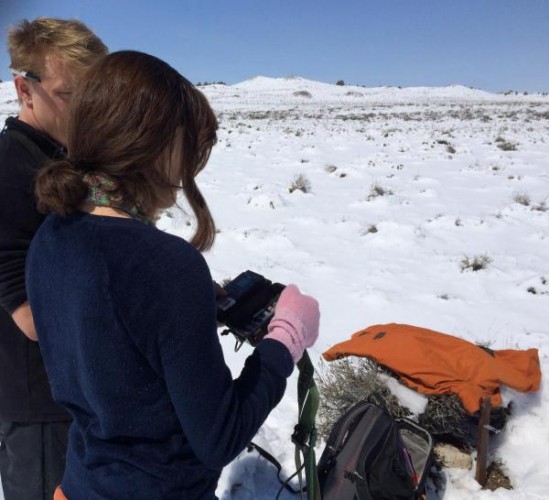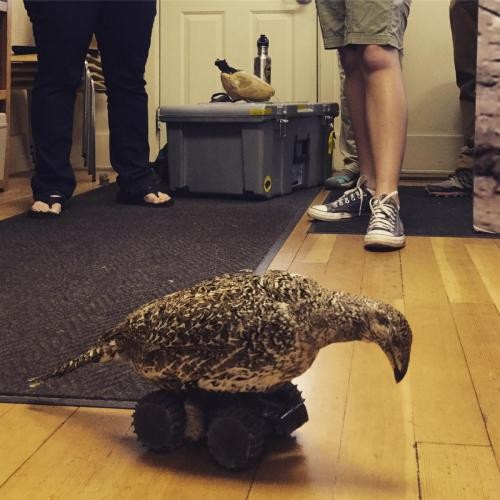Sage-Grouse in the Sierras
Submitted by jmmetes on Thu, 07/13/2017 – 9:31am
This spring, our team, in collaboration with the Patricelli Lab at UC Davis, created and ran a brand new youth-focused citizen science project! With the help of some high school student participants and wildlife biologists at the Bureau of Land Management’s (BLM) field office in California’s Eastern Sierra, we devised a project to study the breeding behavior of greater sage-grouse (Centrocercus urophasianus) at select lek (or mating) sites in the region.
Why sage-grouse citizen science?
Until recently, our case studies have focused on existing projects. The endeavor of building a new project from the ground-up gave us a fresh perspective on what goes into creating a successful project and helped us better understand all the work that’s happening ‘under the hood’ of community and citizen science. And, it allowed us to add a case study involving the Zooniverse crowd-sourcing platform, which is a very different online environment from other cases we’ve examined. Not to mention, sage-grouse ecology is really interesting!
Learning about leks
In the biological sense, the term lek (derived from the Swedish word for “play”) refers to a site where the males of a particular species gather to display and engage in courtship behavior. For sage-grouse, this involves elaborate displays that influence females’ sexual selection for mating. (See a high-speed video of a male sage-grouse display from the Patricelli Lab).
To study the unique behavioral ecology of these birds, ecology graduate student Eric Tymstra wanted to know what times throughout the day sage-grouse are present on these leks. Eric and the students set up field cameras on two lek sites that took timed photos every few minutes throughout a 24-hour cycle. Over the course of two months, these cameras captured 1,000s of photos documenting what was appearing (or not appearing) on the lek.
Using Zooniverse, students classified the presence or absence of sage-grouse in each photo. When grouse appeared in a photo, students also recorded the type of behaviors grouse displayed and whether birds were male or female.
Knowing the times of day sage-grouse are present on a particular lek can help Eric, as well as other scientists and land managers, better understand factors that may influence lekking behavior. This knowledge could help further the conservation of this important sagebrush ecosystem species.
Off-roading robots
Beyond learning about the general ecology of sage-grouse and contributing to new research on the species, students gained a unique perspective on just how creative and quirky science can be. When the lekking season ended in June, students got a visit from Professor Gail Patricelli, lead researcher of the sage-grouse project. She shared about her many field seasons studying sage-grouse in Wyoming, including details on crafty “femmebot” deployment tactics!
A 4-wheel drive taxidermied female grouse equipped with a camera to provide literally a bird’s eye view of the lek up close, the “femmebot” made quite the impression on some fascinated students. While these volunteer high-schoolers were exposed to some of the realistic challenges of science through this project (pre-dawn hours and frigid temperatures during a lek visit, plus a seemingly endless number of photos to classify), they also got the chance to witness and share in the passion and curiosity (not to mention creative quirkiness) that science so often incites.
Connecting students to their local environment
Many of the students participated in this project because they are interested in environmental science as a potential career path and because they care deeply for the place where they live. These interests fit directly into what our team is trying to learn more about through studying YCCS. Particularly, do experiences like the sage-grouse project help develop or change these ambitions?
While there is still much left to learn about this case study, it was rewarding to witness how students well-versed in the common issues affecting rural environments (such as drought, wildfire, development, and tourism) were awed and engaged by discovering new complexities of a familiar place. The sagebrush fields of the Eastern Sierra, overshadowed as they are by the adjacent spine of commanding mountains, still hold many subtle secrets. One student pointed out that it’s easy to think about the mountains, the megafauna, and the forests because those are such prominent parts of the ecosystem. Yet she appreciated learning about the unique plant and animal diversity she didn’t know existed among the sagebrush prior to this project.
Just as studying the behavior of sage-grouse can unlock new knowledge about evolutionary biology and help us understand and protect a fascinating species, our team is excited to continue learning how students experience the research process themselves. Our future depends on how young people come to understand, use, and value science and stewardship to address the complexities of their community and environment.











